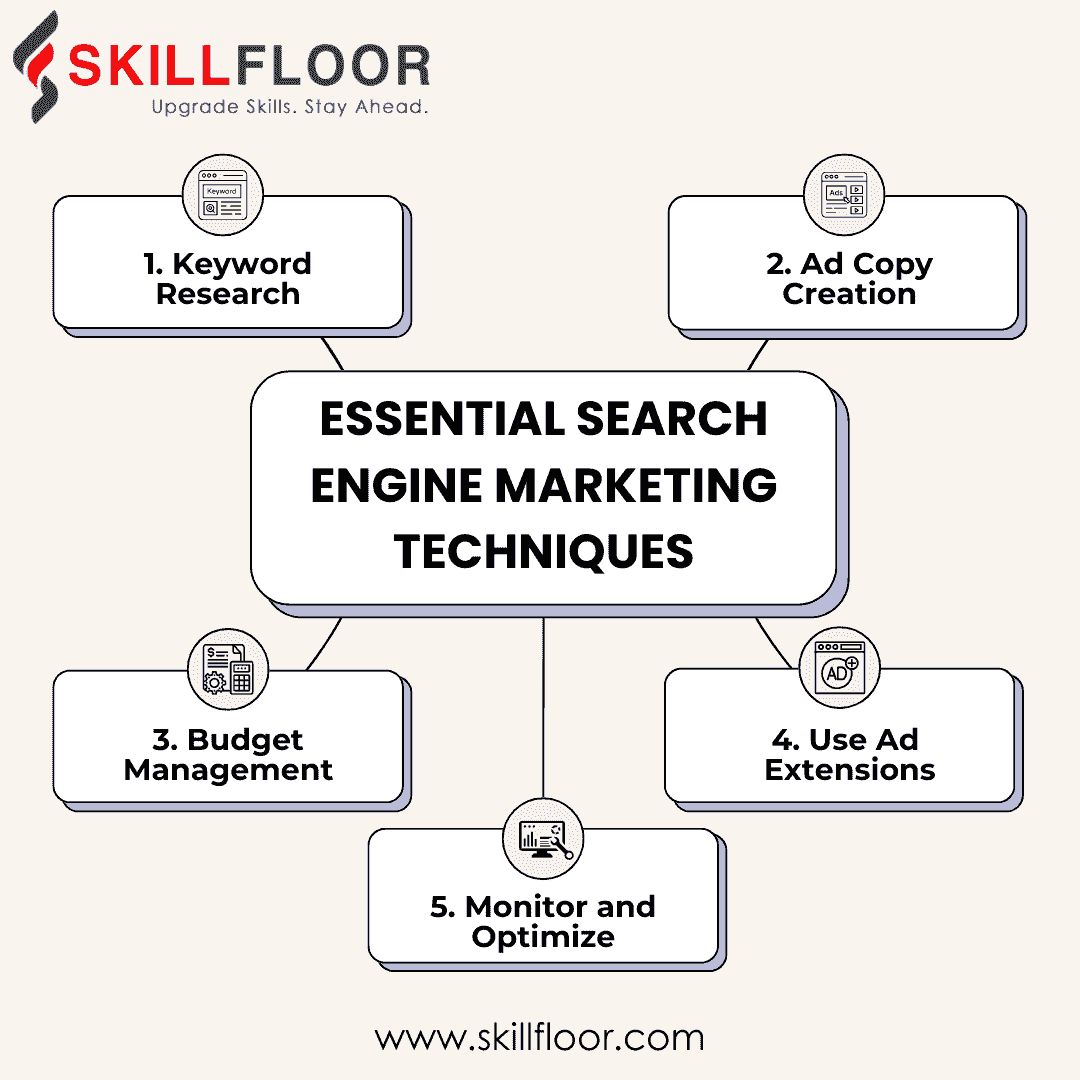Search Engine Marketing Techniques
Explore effective SEM techniques to boost your online presence and drive targeted traffic. Learn strategies for success in search engine marketing

Have you ever considered how to attract the appropriate internet audience to your website? Digital marketing relies heavily on Search Engine Marketing (SEM), which makes your website appear when prospective clients look for goods or services associated with your company.
Focusing on relevant keywords that correspond with what your target audience is looking for is another crucial Search Engine Marketing technique. You may interact with these individuals more successfully with sponsored advertisements, which will make your website stand out from rivals and boost traffic and exposure.
What is Search Engine Marketing (SEM)?
Search Engine Marketing (SEM) is a way to promote your website through paid ads on search engines like Google. It assists companies in ranking highly in search results when consumers browse for goods or services associated with their industry.
Businesses may target particular keywords with SEM to make sure the proper people see their advertising. It's a simple and efficient way to improve exposure, increase possible purchases, and enhance website traffic—all while maintaining financial management.
Importance of SEM for Businesses
-
Businesses may obtain instant visibility in search results with search engine marketing (SEM), which is particularly beneficial for startups or smaller companies looking to expand. This helps potential clients find you immediately.
-
Businesses may use SEM to target audience-relevant keywords, which guarantees that individuals who are actively looking for your goods or services will see your adverts.
-
With the quantifiable outcomes that SEM offers, monitoring the effectiveness of your advertising and modifying your approach to maximize return on investment (ROI) is simple.
-
Flexibility is one of SEM's main advantages as it enables companies to plan budgets, manage expenses, and scale campaigns according to results without wasting money.
-
By positioning their advertising above organic search results, Search Engine Marketing (SEM) may provide businesses with a competitive advantage, keeping them one step ahead of rivals and boosting the likelihood that they will draw in more business.
Types of Search Engine Marketing (SEM):
-
Paid Search Ads: These are text-based advertisements that show up when consumers type in certain keywords into search engine results pages. Ads on Google and Bing are two examples.
-
Display Ads: These advertisements, which target viewers based on their interests, behavior, or demographics rather than particular search queries, show up as banners or pictures on websites.
-
Shopping Ads: Often referred to as Product Listing Ads (PLAs), these advertisements highlight particular goods along with pricing and photos straight from search results—perfect for e-commerce companies.
-
Remarketing Ads: These advertisements are directed to those who have already visited your website, enticing them to come back and finish the purchase or other desired action.
-
Local Search Ads: Appearing in map results or next to inquiries for local services, these advertisements target people who are looking for companies in a particular region.
How does SEM work?
Search Engine Marketing (SEM) functions by allowing companies to make sponsored advertisements that show up in search engine results when consumers type in particular keywords. Advertisers place bids on certain keywords, and the relevancy and bid amount of their advertising determine which ones appear.
The advertiser pays a charge (Pay-Per-Click) when a user clicks on an advertisement. Businesses may swiftly reach potential clients by using this strategy. Platforms for search engine marketing, such as Google Ads, offer tools for allocating funds, focusing on particular demographics, and monitoring the effectiveness of individual campaigns.

Difference between SEO and SEM
|
Aspect |
SEM (Search Engine Marketing) |
|
|
Cost |
Organic, no direct cost but requires time and effort. |
Paid ads, where you pay per click or impression. |
|
Time to See Results |
Takes time, often months, to see significant results. |
Provides immediate visibility once ads are launched. |
|
Positioning in Search Results |
Appears below paid ads, in organic results. |
Ads appear at the top or bottom of search results, above organic listings. |
|
Sustainability |
Long-lasting results that continue after initial efforts. |
Results last only as long as the ads are running and being paid for. |
|
Targeting |
Less control over who sees your content; focuses on keyword optimization. |
Precise targeting by demographics, location, and behavior. |
Keyword Research: The Backbone of SEM
Any effective digital marketing plan starts with keyword research. It helps in determining the precise keywords that members of your target market use to look for goods or services similar to yours. To make sure the proper people see your adverts and content, this approach is essential for both SEO and Search Engine Marketing techniques.
You may bid on phrases that prospective clients are searching for by incorporating keyword research into your Search Engine Marketing techniques. Focusing on high-performing, relevant keywords will help you increase exposure, optimize your campaigns, and drive more targeted visitors to your website.
How to Choose the Right Keywords
-
Understand Your Audience: Finding out what your target audience searches for is the first step in selecting the appropriate keywords. You may find phrases that appeal to their requirements and interests by conducting keyword research.
-
Use Keyword Tools: Find popular and relevant keywords by using tools such as SEMrush or Google Keyword Planner. These tools help you choose keywords more wisely by giving you information about search traffic and competitiveness.
-
Focus on Long-Tail Keywords: Usually with less competition, long-tail keywords are more focused phrases. Your Search Engine Marketing will be more effective if they bring in more focused visitors to your website.
-
Analyze Competitors: Take a look at the keywords that your rivals are employing. You may use this to find openings or holes in your market and to generate ideas for your keyword plan.
-
Consider Search Intent: Select keywords that are consistent with the search's purpose. Your campaign will perform better if your keyword selections align with the aims of your target audience—whether they are trying to buy, learn, or compare.
Keyword Intent
Digital marketing success depends on knowing the intent behind keywords. Determining what people want to search for with certain phrases is part of the process. One way to learn more about these search intentions is to use a Keyword Research tool. This enables you to more closely match your Search Engine Marketing techniques to the real needs of your visitors. You'll draw in more relevant traffic and increase the efficacy of your campaign by tailoring your advertising and content to their demands.
Comparing Short-tail and Long-tail Keywords:
|
Aspect |
Short-Tail Keywords |
Long-Tail Keywords |
|
Definition |
General, one or two words. |
Longer phrases, typically three or more words. |
|
Search Volume |
Higher search volume due to broad terms. |
Lower search volume, more specific queries. |
|
Competition |
More competitive and harder to rank for. |
Less competitive, easier to rank for. |
|
User Intent |
Often vague; users may be in the early research stage. |
More specific; users have clearer intent or are closer to purchasing. |
|
Conversion Rate |
Generally lower; searches are less specific. |
Typically higher; searches are more targeted and relevant. |
Effective Tools for Keyword Research:
-
Google Keyword Planner: Provides keyword ideas and search volume data. Perfect for organizing SEO and paid search campaigns.
-
SEMrush: Includes search volume, degree of competition, and similar terms in its thorough keyword analysis. Excellent for comprehensive study.
-
Ahrefs: It provides keyword ideas, search volume, and difficulty rankings and is well-known for its large database.
-
Moz Keyword Explorer: Enables you to find and rank keywords based on characteristics such as search volume, difficulty, and potential.
-
Ubersuggest: Provides search volume, SEO difficulties, and suggested keywords. helpful for tracking results and coming up with keyword suggestions.
Setting Up Your First SEM Campaign
One of the most popular platforms for Search Engine Marketing techniques is Google Ads, which assists companies in developing advertisements that show up in Google search results. You may efficiently target the proper audience with Google Ads by managing your budget, customizing your campaigns, and focusing on particular keywords.
Bing Ads, which targets users of Bing and Yahoo, and Amazon Advertising, an excellent choice for e-commerce enterprises, are additional well-liked platforms for Search Engine Marketing techniques in addition to Google Ads. You may use distinct tactics and connect with various audiences on each channel.
How to Create a Campaign Step-by-Step
-
Create a Google Ads account: Log in using a Google account (such as Gmail) to begin quickly configuring your campaign.
-
Set a budget: Establish daily limitations and a spending restriction to make sure you don't go over your allocated advertising budget.
-
Choose your campaign type: A Search Network Campaign, which places advertisements straight in Google search results, is the best option for beginners.
-
Create ad groups: To efficiently target certain queries, put keywords together into ad groupings, such as "gluten-free cupcakes" or "chocolate cupcakes."
-
Write your ads: Advertisements should be brief, understandable, and interesting. Include a compelling Call to Action (CTA) along with pertinent keywords.
-
Launch your campaign: Launch your campaign when everything has been set up. When visitors look up relevant terms, your adverts will show up.
Essential Search Engine Marketing Techniques for Beginners
-
Keyword Research: Determine which pertinent keywords people in your audience use while looking for goods or services. Find important and well-liked phrases with the use of tools such as Google Keyword Planner.
-
Ad Copy Creation: To get viewers to click and convert, create compelling advertisements with a clear call to action (CTA) and pertinent keywords.

-
Budget Management: To make sure you remain within your constraints and optimize efficiency, start with a realistic budget, keep an eye on your expenditure, and make adjustments based on the success of your campaigns.
-
Use Ad Extensions: To boost click-through rates and exposure, provide helpful information in your advertising, like locations, phone numbers, or more links.
-
Monitor and Optimize: To enhance performance and more successfully reach your audience, regularly review the campaign's results and make necessary adjustments to the ad wording, keywords, and bids.
How to Optimize your Search Engine Marketing (SEM) Campaign:
-
A/B Testing: Try out several ad variants to determine which works best. Find the most successful combination by changing the headlines, descriptions, or call to action.
-
Use Negative Keywords: By including negative keywords, you may increase targeting precision and save money by stopping your advertisements from appearing on pointless searches.
-
Improve Quality Score: To raise your ad's Quality Score, cut expenses, and boost exposure, concentrate on improving ad relevance, landing page experience, and predicted click-through rate.
-
Optimize Landing Pages: Make sure your landing page loads quickly, is relevant to the advertisement, and offers an excellent user experience to boost conversions.
-
Monitor Performance Metrics: Continually monitor important metrics like conversion rates, CTR, and CPC. To continuously improve, change your ad campaigns, bids, and keywords based on data-driven insights.
Monitoring and Analyzing Your Results
A crucial Search Engine Marketing technique is tracking and evaluating your results. Campaign optimization, performance monitoring, and determining your optimal return on investment are all aided by it.
-
Track Click-Through Rate (CTR): Track the proportion of viewers who click on your advertisements. A greater CTR suggests that your advertisements are interesting and relevant to your target market.
-
Analyze Cost-Per-Click (CPC): Be aware of the cost associated with each click. More traffic for less money is shown by a lower cost-per-click.
-
Measure Conversion Rate: Count the number of people who click on your advertisement and then perform an action (buy, join up, etc.). Your landing page and advertisement are effective if you have a better conversion rate.
-
Monitor Return on Ad Spend (ROAS): Determine the money your advertisements are bringing in about their expense. Your campaign is lucrative if your ROAS is positive.
-
Use Analytics Tools: With the use of comprehensive analytics on user behavior from platforms like Google Analytics, you can adjust your campaign based on real performance information.
Common SEM Mistakes to Avoid
Negative keywords, which can squander ad spend by presenting advertisements for inappropriate queries, are a typical Search Engine Marketing technique blunder. Always pay close attention to targeted refinement.
-
Overbidding on Keywords: Overspending on competitive keywords might quickly deplete your funds without producing any returns. Start with more reasonably priced, relevant keywords.
-
Ignoring Negative Keywords: Negative keyword overload might result in pointless clicks, squandering your ad budget. To improve your targeting, include them.
-
Poor Ad Copy: You may lower click-through rates by writing ads that are vague or bland. Make sure the content in your advertisements is striking, easy to understand, and has a clear call to action.
-
Not Tracking Conversions: You won't be able to determine which advertisements are generating results if you don't monitor user activities after clicking. Conversion tracking should be set up to gauge efficacy.
-
Neglecting Landing Page Optimization: Conversions may be lost by a landing page that loads slowly or isn't relevant. Make sure your landing page is user-friendly and complements the advertisement.
You may greatly increase your online visibility and attract relevant visitors to your website by mastering Search Engine Marketing techniques. You may boost exposure, draw in a suitable clientele, and expand your company by concentrating on the appropriate tactics, which include keyword research, ad optimization, and performance tracking. Beginners must start small, try a variety of things, and figure out what suits their unique objectives the best. You may increase the effectiveness of your ads and get better results over time by consistently fine-tuning your campaigns and implementing the latest Search Engine Marketing techniques. You'll be well on your way to success with SEM if you keep learning and making adjustments!





























































